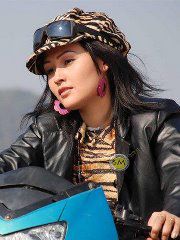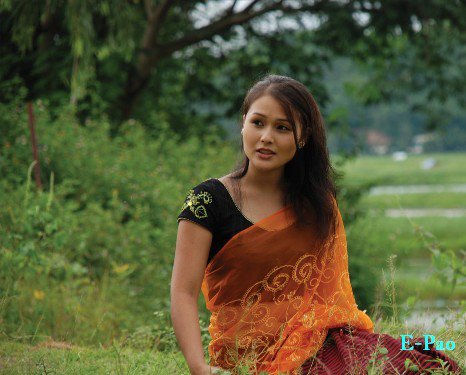Abenao Elangbam
This is a collection of articles archived because of Readers can send additional information, corrections, photographs and even Readers will be able to edit existing articles and post new articles directly
|
The authors of this page, which has been archived by a mayang, are:
i) Facebook
ii) Anon E-pao
iii) W Rorrkychand Singh/ July 17, 2012
Contents |
Abenao: Curriculum vitae
Birth name: Sonia Elangbam
Screen name: Abenao (sometimes with Elangbam) Abenao Elangbam
Parents: Elangbam Chaoba and Elangbam Ongbi Ebemnungshi Devi
Native place: Top Khongnangkhong, Imphal East
Address: Top Khongnang Makhong, Porompat DC Road
Born 28 September 1980 (according to her Facebook page; her fans insist she was born in 1988 or 1994; Manipur’s leading film journalist W Rorrkychand Singh says it is 1986)
Height: 5' 3”
Hair Colour: Dark Brown
Education: MA Adult Education, Manipur University
Favourite film: “Papagi Cycle”
Favourite Book/Author: “Bor Saheb Ongbi Sanatombi”, by MK Binodini
Filmography: Thoiba-Thoibi, Akhunba Mani, Red Rose, Chumthang Makhong, Naoshum, Liklai, Leikang Thambal, Manithoiba, Da Sadananda.
MESMERIZING THE MASSES: ABENAO, THE RISING STAR/ By E-pao
If there ever has been a Manipur film actress that, it is none other than Elangbam Abenao is loved not only for her performance but also the 'down to earth' image of simplicity she possesses both on and off the screen, and for embodying mesmerizing innocence. Her 'child-like' nature seems to conceal her ever improving 'maturity' as an actress.
Her first major screen role was Thoiba Thoibi (2006), which was a success. Her first film was actually not Thoiba Thobi but another film by one of her relatives. She was introduced to films for the first time in this flick. It was a small role and was not a very significant one. It was with Thoiba Thoibi that she was formally launched into the world of Manipuri digital films.
(W Rorrkychand Singh ads that the unnamed debut film was Chingjaogum Lepliba Thamoi (2005) and that her ‘First solo debut‘ was in Naosum.)
Abenao, in fact started her acting career with stage performances. She was introduced to the art of acting by people behind People's Arts and Dramatics Association, Top Khongang Makhong, Imphal and is still associated with the group. "Besides acting on stage and for films, I also love singing and reading", says Abenao with an inimitable blink on her eyes and an infectious smile.
With over nine films to her kitty, she recalls not too many hardships on her way to stardom. Among best of her performances were in films like Thoiba Thoibi, Naoshum, Akhunba Mani, Red Rose, Liklai, Leikang Thambal, Mani Thoiba, Chumthang Makhong, Da Sadananda etc.
‘Red Rose’
She has tried giving her best effort in all the films released so far. When asked to recall the most memorable events during her acting career so far, she pauses for a while and says with a smile, "During the shooting of Red Rose, I had to endure with one of the most gruelling experiences. There was one particular scene shot during freezing winter, I was lying on the ground with my body limbs tied and mouth shut for hours till the final take was complete. I could feel the icy cold earth beneath my body, yet I did not complain. My conditions worsen when make-up artists present on the location spayed ice-cold water over my face and body to give the 'sweat' effect. And I was lying there actually trembling with cold. I will not easily forget that particular shoot".
’Naoshum’
Then, Abenao goes on to narrate another unforgettable experience. "It was during the shooting of the last scenes in Naoshum. In the film, I had already consumed poison/liquid insecticide with my on-screen mother. To give a realistic image to the after effect of consuming poisonous substance and the vomit, I was made to put in my mouth big chunks of white tooth-paste from the tube. I had this soft and big melting chunk of white tooth-paste in mouth for over three hours. After the sequence was shot and with the inflamed tissues all over my mouth and tongue, I could not properly consume food for many days together."
Support
While valuing the works of her co-actors, she says she has learned a lot from male actors and stars like Sadananda and Kaiku. "All my co-actors have been very supportive and they have always helped me improve my performance. Directors like brother Romie too have helped me in every step I take. I express my gratitude to them".
Childhood
While narrating experiences from her acting career, she also gleefully reminisces one of her childhood experience. "You know, I had fractured my arm twice in my life. The first time was when my elder brother and I were playing as tiny tots. The second time was again with my brother. My brother liked me a lot. So, while I was recovering from the first fracture, he lifted me and tried holding me up on his arms like all loving elder brothers do. I slipped out of his arms and fell on the ground fracturing the arm again."
Family
It is not only her brother who loves her. She has two more female siblings and supportive parents. Realizing the fact that it is not safe for the youth to venture out into the nooks and corner of the state, particularly during politically disturbed situations where outbreak of violence lurks large, Abenao says her mother accompanies her where ever she goes out for long for film shoots. Her mother has always encouraged her to live her dreams as a 'good woman'.
A fan comments, ‘She is good. But sometimes slippery enough to perform the same acting in the same way in two or more different films and at other times overacting a little bit.‘
Abenao’s worldview/ By W Rorrkychand Singh
Excerpts from an interview with W Rorrkychand Singh:
Q(W Rorrkychand Singh). How many films were done in a year?
A(Abenao). “In a year around 10 movies were done.”
Q(W Rorrkychand Singh). Do you think that Manipuri culture is diminishing day by day?
A(Abenao). “No! Our culture is active and it will be forever. We have our own pattern and styles like any other society. How can a society simply ignore its culture and adopt others. Let me ask a question, on the day of Cheiraoba have you ever seen any married woman goes to their parental house without sporting Multani Mitti (Fuller’s Earth), and donning shorts? Take the case of marriage; if one goes on casual attire, I am pretty sure that he/she would be a persona- non grata. Considering the nature of a few, we could not say, our culture is dying.”
Q(W Rorrkychand Singh). Your experience from “Chingjaogum Lepliba Thamoi” to your latest flick “Sakhenbi Eteima”
A(Abenao). “Its an amalgam of joy and wretched, as the industry does not have a studio and most of the films were centered around the lives of the native people, shooting were mainly done at the roadsides or hillside, and even sometimes in someone’s bedroom. Luckily, a good number of the people acknowledge us and receives well in most of the locations, however its also there some who simply react to us, “leirak khullak ki film hek namladana”.
Q(W Rorrkychand Singh). The grapevine is that the morals of Manipuri film actors are lousy, how do you observe?
A(Abenao). “We are also human being not different from others, and they (common people) are also not different from us, the only difference is that we appear on screen and its being our weak point where we became their central point. Its nature to talk about us this or that but the reality is different from the view.”
Filmography
2009 Nobap
2010 Thoudang
2011 Phijigee Mani
2013 Tabunungda Akaiba Likli
2014 Eidee Kadaida
2014 Sathiba Danger
2014 VDF Thasana
2014 Nongmatang
2015 Hingbagee Mahao
2016 Mashingkha
2016 Thamoi Ahum
2016 Ingagee Thanil
See also
Assamese cinema: This page has, at the bottom, links to several other articles in Indpaedia.com related to Assamese cinema.
and individual pages about
Abenao Elangbam



